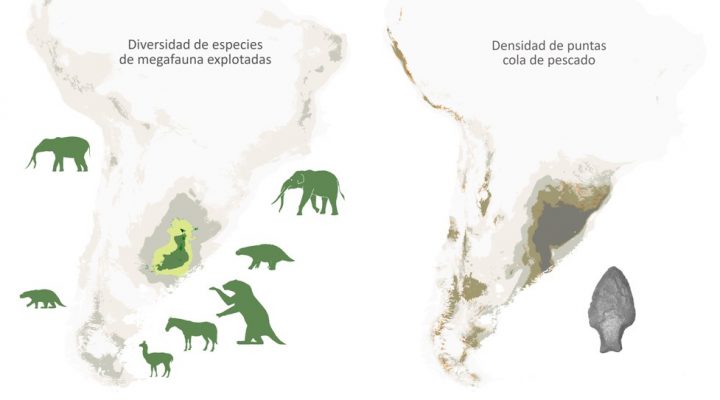EXACT AND NATURAL SCIENCES
Human beings may be much more responsible for the megafaunal extinction
After analyzing more than five hundred fossil records and spearheads, this hypothesis was formulated by two CONICET researchers. The study was published in Nature Communications.
“We believe that human beings are the main responsible for the South American megafaunal extinction” affirm Lucian Prates and Ivan Perez, CONICET researchers at the ‘Faculty of Natural Sciences and the Museum of the National University of La Plata (FCNyM, UNLP) and authors of a study that was published in Nature Communications. Based on a number of fossil and archeological records from all the subcontinent, the analysis links the hunting activity of the first groups of people with a demographic decline and subsequent disappearance of all large mammal species that took place at the end of the Pleistocene, between 13 and 11 thousand years ago.
That is how this study contradicts the so far most accepted hypothesis that for South American archeology, these great mammals disappeared as a result of environmental changes such as the increase in temperature and the alteration in the vegetation that occurred after the last ice age, about 18 thousand years ago, causing the condition for a mass extinction. Instead, this new research work stresses the temporal and geographical coincides that existed between the evidences of megafauna and that of a very particular spearhead known as “fish tail”, similar to another called “Clovis” which existed only in North America and is associated with the hunting of mammoths.
“In both cases, they are large and wide tools made with sophisticated technology. Their period of existence is very short -between 13 and 11 thousand years old- and later they are not found,” describes Prates. Besides, the scientists observed that during the same period the demographic curve of human beings began to decrease, a moment that also coincided with the last stage of extinction of the megafauna. The evidence was the product of the crossing of 51 temporal records of the fishtail tip and 269 fossils belonging to ten species of the megafauna -among them the American horse and the megaterium or giant sloth-, all dated by the radiocarbon technique that determines the age of the materials that contain carbon.
“Firstly, we found that the megafauna grew at a high rate until one point -12,900 years ago- in which it began to decline sharply. This coincides exactly when the fishtail tips appeared, so we suppose that when humans obtained this new technology they began to hunt these mammals, and hence the decline in these populations,” explains Perez. “This situation lasts for 2,000 years and ends with the simultaneous disappearance of the animals and the spearheads, which shows us that they were intimately linked,” Prates adds. In this scenario, the drop in the human demographic curve above mentioned is explained because the same depredation of the fauna that caused its gradual decline had an effect on the human groups whose populations were also decreasing due to the disappearance of one of their main subsistence resources.
In parallel, the study includes a geographical analysis that comprises 156 spatial records of fishtail tips and another 204 corresponding to specimens of the megafauna, along with 1660 archeological sites between 15 and 7 thousand years old throughout the entire South American territory. Furthermore, the results support the author’s idea: megafauna are distributed in the same places where weapons appear, “which means that the people who hunted with that technology were located in the regions where these animals lived -the open steppes of the pampas of Uruguay, southern Brazil and Argentina, and Patagonia,” Prates explains.
“Based on this information and the combination of paleontological and archeological evidence, our study claims that the human being was the main responsible for the extinction of the megafauna but not for having compulsively attacked all species as assures a classical hypothesis raised more than 40 years ago by the North American paleontologist Paul Martin. In this case we assume that the people only dedicated themselves to hunting a few species, but that anyway an imbalance was generated in the ecological network which in addition to climatic changes eventually triggered a general collapse of the entire community of large mammals,” the researcher concludes.
By Mercedes Benialgo
References:
Prates, L., Perez, S.I. Late Pleistocene South American megafaunal extinctions associated with rise of Fishtail points and human population. Nat Commun 12, 2175 (2021). https://doi.org/10.1038/s41467-021-22506-4
About the study:
Luciano R. Prates. Independent researcher. FCNyM, UNLP.
Ivan Pérez. Independent researcher. FCNyM, UNLP.
